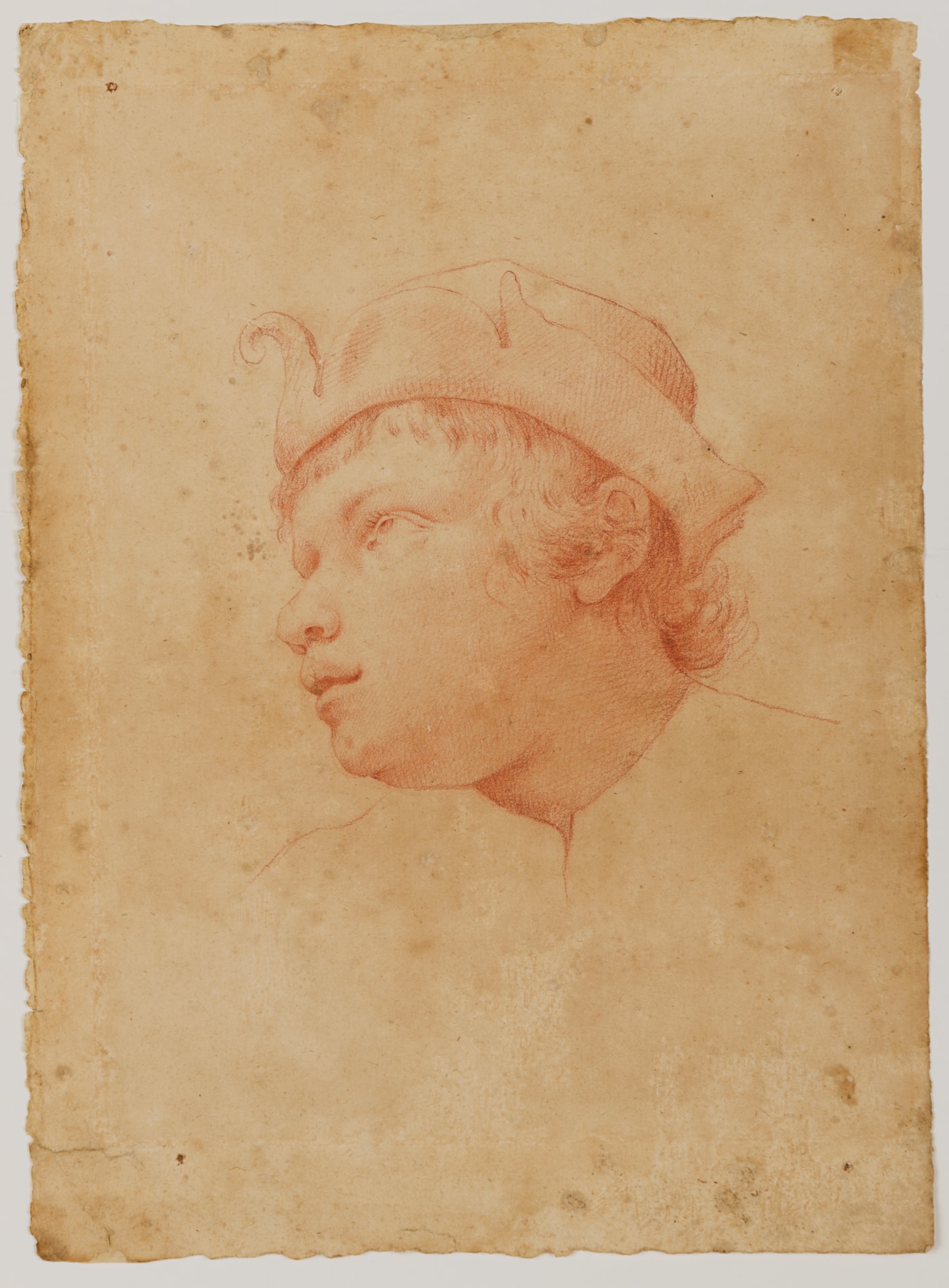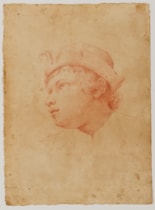Carlo DOLCI
(Florence 1616 - Florence 1687)
The Head of a Boy Wearing a Cap
Sold
Red chalk on buff paper.
248 x 180 mm. (9 3/4 x 7 1/8 in.) [sheet]
248 x 180 mm. (9 3/4 x 7 1/8 in.) [sheet]
Carlo Dolci has been described as ‘the most sophisticated draughtsman of the Florentine seicento’, and his drawings were owned by such prominent Florentine collectors of his day as Baldinucci and Cardinal Leopoldo de’ Medici. The present sheet is a particularly fine example of the artist’s polished draughtsmanship, as has been noted by the Dolci scholar Francesca Baldassari: ‘This beautiful face of a young man, meticulously defined and with great refinement in every detail, is stylistically one of the most expressive heads drawn by Carlo Dolci. Within his graphic corpus, the most striking comparisons are to be found with the ‘Portrait of the Artist’s Wife’ (Paris, Musée du Louvre, Inv.1140), characterized by similar minute marks and intricate crosshatching, which in this drawing is particularly visible in the neck and the cheerful cap. A peculiar characteristic of Dolci, also evident in this ‘Head of a Young Man’, is moreover that the image is both ‘ideal’ and ‘natural’, which he achieves by defining and punctuating the roundness and purity of the face in every detail. Since it cannot be linked to any known work by Dolci, this [drawing] would appear to belong to the category of autonomous studies, conceived as works of art in themselves, of which the artist produced many examples. Although it is quite difficult to date Dolci’s autonomous graphic works due to the invariability of his drawing style, this ‘Head of a Young Man’ would seem to be dated between the 1640s and 1660s, when the painter broke away from [Matteo] Rosselli’s decorative style and achieved results similar to the purist and sharply defined style of his fellow countrymen Lorenzo Lippi and Ottavio Vannini.’
Dolci’s portrait drawings are among his most appealing works as a draughtsman. As another scholar has noted, ‘Portrait drawings…of family or friends, whether autonomous or preparatory for paintings in other genres, are not rare in Dolci’s oeuvre. Some of the most beautiful [are] made in the red or black, or red-and-black pencil technique traditional in Florence.’ Among other stylistically comparable portrait drawings in red chalk by Dolci are studies of a small child6 and a portrait of Filippo Baldinucci, both in the Louvre, a drawing of a sleeping child in the Uffizi, and a drawing of a young boy looking upwards, which was on the London art market in 2000.
Dolci’s portrait drawings are among his most appealing works as a draughtsman. As another scholar has noted, ‘Portrait drawings…of family or friends, whether autonomous or preparatory for paintings in other genres, are not rare in Dolci’s oeuvre. Some of the most beautiful [are] made in the red or black, or red-and-black pencil technique traditional in Florence.’ Among other stylistically comparable portrait drawings in red chalk by Dolci are studies of a small child6 and a portrait of Filippo Baldinucci, both in the Louvre, a drawing of a sleeping child in the Uffizi, and a drawing of a young boy looking upwards, which was on the London art market in 2000.
Carlo Dolci’s close friend, pupil and early biographer Filippo Baldinucci provides a fairly complete and thorough account of the painter’s life, written shortly after his death. A precocious artist, Dolci entered the studio of the painter Jacopo Vignali in 1625, at the age of nine, and within a few years was producing some striking independent portraits. Dolci probably left Vignali’s studio in the early 1640s, and in 1648 was admitted into the Florentine Accademia del Disegno. He soon became one of the leading painters in 17th century Florence, enjoying a career that lasted some sixty years. Baldinucci notes that he was a particularly devout man, and this is reflected in much of his work. The largest part of Dolci’s output, and the work for which he was best known, are his religious and devotional pictures, characterized by a meticulous and refined technique, rich colour, a jewel-like clarity and a high degree of finish. (In his 1677 guide to Florence, Giovanni Cinelli described the artist’s work as ‘pittura bellissima e rara’.) Furthermore, as one modern scholar has noted, ‘Dolci catered to the opulent taste of the Medici Grand-ducal court, embellishing his ecstatic, melancholy or tender figures with splendid jewels, gorgeous materials and flowers, real gold and precious ultramarine.’
Since he worked very slowly (a trait that led to some stinging criticism from Luca Giordano), Dolci produced relatively few paintings a year. These were much sought-after, particularly among the aristocracy and nobility, and he became one of the most highly-paid painters in Florence. Chief among his important patrons was Vittoria Della Rovere, Grand Duchess of Tuscany, and her son, the Grand Duke Cosimo III de’ Medici, along with several other members of the Medici family as well as other important Florentine noble families, such as the Corsini, Ginori, Salviati and Quaratesi. Although Dolci worked for almost his entire career in Florence, his reputation travelled well beyond Tuscany, and he received numerous commissions and sold several works to Venetian and English collectors. A chronology of his oeuvre is made easier by the fact that he often inscribed on the backs of his paintings the date that the canvas was begun or completed, and sometimes the name of the patron. Dolci’s paintings were widely copied after his death, which led to a decline in his reputation in later years.
Since he worked very slowly (a trait that led to some stinging criticism from Luca Giordano), Dolci produced relatively few paintings a year. These were much sought-after, particularly among the aristocracy and nobility, and he became one of the most highly-paid painters in Florence. Chief among his important patrons was Vittoria Della Rovere, Grand Duchess of Tuscany, and her son, the Grand Duke Cosimo III de’ Medici, along with several other members of the Medici family as well as other important Florentine noble families, such as the Corsini, Ginori, Salviati and Quaratesi. Although Dolci worked for almost his entire career in Florence, his reputation travelled well beyond Tuscany, and he received numerous commissions and sold several works to Venetian and English collectors. A chronology of his oeuvre is made easier by the fact that he often inscribed on the backs of his paintings the date that the canvas was begun or completed, and sometimes the name of the patron. Dolci’s paintings were widely copied after his death, which led to a decline in his reputation in later years.
Provenance
Private collection, Florence
Stephen Ongpin Fine Art, London
Private collection, Germany.
Stephen Ongpin Fine Art, London
Private collection, Germany.




